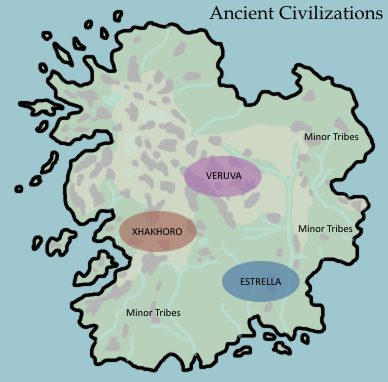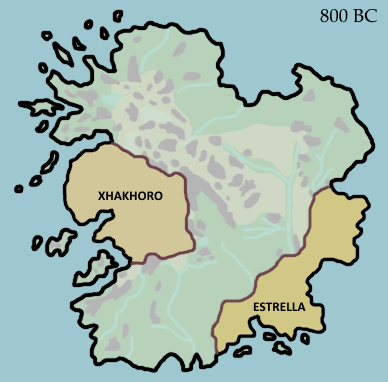Ancient History (Pre 480)
3500 BC | EITADOR | Following the desertification of the Sahara, many people from North Africa
travel west, island hopping through the canaries until they reach Eitador. This is the continent's
first major population influx, and results in the creation of many minor settlements.
2700 BC | EITADOR | Varhakka becomes the continent's first true city, attracting people due
to its religious significance in the Mezahir religion. A council of priests rule over the population
and create a strict heirarchy of priest, noble, freeman, and slave.
2000 BC | EITADOR | Eitador's earliest evidenced tin mining operation begins in the Nauticau region.
1900 BC | VERUVA | Eitador's first kingdom is established. It is centered around Veruva mountain.
Not much is known about its early kings aside from the brutal penal systems they put in place.
1895 BC | VERUVA | The kingdom acquires Varhakka by supporting a faction of its priest caste in staging a coup.
The focus of worship in the Mezahir religion shifts from the Sun Goddess to the Moon Goddess.
1880 BC | ATTRAKA | Attraka, a minor kingdom to the south east of Veruva, makes threats that are dismissed as petty jealousy.
1875 BC | VERUVA | The earliest Veruvan ziggurat is built. It is dedicated to the Moon Goddess with a month long
celebration. On the final day, a number of people supposedly offered themselves up as willing human sacrifices.
1874 BC | ATTRAKA | Attraka begin building a floating fortress with a tower to rival the moon ziggurat.
1870 BC | VERUVA | Attraka take Veruva by surprise, burning many fields and villages to the ground before turning their eyes on Varhakka.
Veruva narrowly fight them back by quickly deploying thousands of soldiers to the defence. They record this event in their art as a miracle from the Moon Goddess.
1868 BC | VERUVA | Veruva send their soldiers into Attraka and devastate the kingdom on an unprecedented scale. Attraka report
entire villages being flayed.
1867 BC | ATTRAKA | The king commits suicide inside the floating fortress as Veruvan soldiers camp on the shore.
The kingdom is entirely absorbed by its rival.
1850 BC | VERUVA | The first parts of a huge cave system inside Veruva mountain are constructed.
The tunnels were capable of housing thousands people, but their purpose remains a mystery.
1750 BC | VERUVA | Overfarming in the Veruvan valley makes feeding the population more difficult, leading to riots.
1500 BC | VERUVA | The kingdom of Veruva ceases to exist around this time for unknown reasons. Its capital is abandoned.
The central leadership of Mezahir go with it, and it ceases to exist as an organized religion.
1400 BC | PANJAR | The minor citystate of Panjar, once a Veruvan settlement, attempt a revival of Mezahir
under the leadership of their Sun Goddess temple. The nobility are dissatisfied, as they do not want to have to answer to priests
about what they can and can't do. It is ultimately decided that only commoners have to follow religious law.
1300 BC | PANJAR | Panjar fight a series of wars with the citystates across the river to its north for a period of roughly 100 years.
1222 BC | PANJAR | The ruling high council of Panjar is completely wiped out in an ambush as they return from a failed peace conference with their neighbors.
The neighboring citystates are blamed, but cooperation by disgruntled peasants is also suspected.
1220 BC | PANJAR | The new council is dominated by loyalists of Chancellor Kunri Au'maejiu. They implement laws which increase his authority significantly.
Panjar expand rapidly for a few years before their wars begin to draw to stalemates.
1111 BC | PANJAR | Dana Au'maejiu, a descendent of Chancellor Kunri, is declared Queen of Panjar. The rivers of the Veruvan valley flood in the year preceding
her coronation, and the bumper crop is seen as a sign that she was chosen by the gods. She proves to be a very popular ruler.
1000 BC | EITADOR | Most of the continent contains either small settlements or roaming tribes.
The mountainous north east and the interior deserts are the least populated areas by a significant margin.
930 BC | XHAKHORO | The kingdom of Xhakhoro is created. It's Eitador's largest unified civilization, and begins
a military campaign to expand north into bits of territory once considered to be part of Attraka.
900 BC | PANJAR | The rivers of the Veruvan valley begin to shrink as mountain aquifiers dry up. The population begins to stagnate as many people migrate
by boat towards Eitador's southern coast.
890 BC | XHAKHORO | A huge earthquake causes great damage to the north of the country and destroys most of the already rare pieces of Attrakan architecture.
880 BC | EITADOR | Raider cultures from the north grow increasingly aggressive, spurring many cities to either submit to more powerful
neighbors or to sign mutual defence pacts with them. Xhakhoro and Panjar both benefit.
864 BC | PANJAR | Panjar attack Xhakhoro. They use similar military tactics to those used by Veruva in the mountains of the former Attrakan kingdom.
863 BC | XHAKHORO | A band of soldiers named 'The Daughters of the Mountain' are said to have singlehandedly defeated a Panjaran army three times their size
after luring them into a tight valley and then launching a surprise attack.
861 BC | XHAKHORO | Panjar is defeated. The kingdom collapses and Xhakhoro destroy most of their military infrastructure. The Au'maejiu family are pushed into exile.
Xhakhoro find it hard to control the newly acquired territories as they are too far away from their heartland and require travel over many miles of rough terrain.
858 BC | XHAKHORO | A violent peasant's revolt occurs against the Xhakhoran governor of Panjar. Xhakhorans in Panjar are regularly harrassed and assaulted.
855 BC | XHAKHORO | The governor in Panjar is replaced with a local. He preaches the importance of friendship and peace between Xhakhorans and Panjarans
while simultaneously arguing that Panjar should be allowed more autonomy.
854 BC | XHAKHORO | Disease spreads through the fields of the Xhakhoran heartland, causing a famine that hits the nation hard.
Outlier regions suffer the most, as they had been relying largely on imports from the central provinces.
853 BC | XHAKHORO | Xhakhoran soldiers officially abandon all of the formerly Panjaran cities. They're believed to have been very costly to maintain,
and it arguably did more damage to Xhakhoro than the actual war.
850 BC | EITADOR | Trade is established with the Phoenicians. Settlements in Nauticau begin to flourish.
Knowledge and culture are exchanged as well as goods.
Map of Ancient Civilizations in Eitador

825 BC | PANJAR | The Au'maejiu return to Panjar with mercenaries from the north, in an attempt to restore their rule.
They gain control of the city for approximately six months, during which time the mercenaries loot the temples and homes of the Panjaran people.
When the mercenaries leave, an immediate and quick revolt sees the remnants of the Au'maejiu family tortured and executed.
800 BC | ETSTRI'A | The kingdom of Etstri'a is formed in southern Eitador, bringing together
settlements in Nauticau and the rest of the south east coastline. Their good trade links allow them to advance faster
than the rest of the continent. Their king is named Rmni'ta, 'the Shoulder of the World', and he becomes immensely rich.
Map of Eitador circa 800 BC

795 BC | ETSTRI'A | A short but bloody civil war occurs when settlements in the north of the kingdom argue that they were tricked into
joining it. They launch a major rebellion, but are defeated at the Battle of Astarii. This place would later be known as the city of Astaria.
792 BC | ETSTRI'A | Rmni'ta thanks the ocean gods for his success. He dedicates a huge temple in Astarii to Posteya, God of the Waves.
The temple is believed to have had a 85m tall lighthouse, making it the tallest building on Earth until the Pharos Lighthouse in 280 BC
776 BC | GLOBAL | The Olympic Games are established in Greece.
758 BC | ETSTRI'A | Rmni'ta II inherits the title of king, but lesser titles are split between their four siblings,
significantly weakening the central authority of the kingdom.
580 BC | XHAKHORO | An Order of Assassins named The Cloud of Knives is created by King Hadior of Xhakhoro.
513 BC | ETSTRI'A | The Queen threatens Xhahkhoro after The Cloud of Knives carry out a wave of assassinations in Estrellan territory.
She sends assassins of her own in retaliation, and this is now often referred to as The Whispered War.
509 BC | GLOBAL | The Roman Republic is created.
400 BC | XHAKHORO | The Cloud of Knives is officially disbanded after an agreement is struck with Etstri'a.
They continue to operate, however, from new hideouts that are now independent of the crown.
Some in Etstri'a believed that Xhakhoro merely pretended to disband the order, but there was also evidence that The Cloud of Knives was
by this point being funded by nobility on both sides.
387 BC | ETSTRI'A | The king of Etstri'a is assassinated, leaving behind a one-year-old son.
385 BC | ETSTRI'A | A coup removes the child-king Ealos from throne in favour of his uncle Malus, who had previously been official spymaster.
370 BC | ETSTRI'A | A civil war breaks out with multiple major factions supporting King Malus, Prince Ealos, as well as distant relatives.
369 BC | ETSTRI'A | Malus is victorious in the civil war and the 18-year-old Ealos is scheduled to be put to be executed. This move is unpopular,
as even many of the nobles closest to Malus are still sympathetic to Ealos, and so the date of the execution ends up being continually postponed.
359 BC | ETSTRI'A | Malus dies after a brief illness believed to have been bought on by food poisoning. His daughter, Queen Ravaea, is crowned.
She immediately sets Ealos free and grants him a major duchy. They had become very close friends as she visited him often during his imprisonment.
355 BC | ETSTRI'A | Queen Ravaea gives birth to a son who is believed by many to have been fathered as a result of an adulterous and incestuous tryst with Prince Ealos.
353 BC | ETSTRI'A | The husband of Queen Ravaea dies in a hunting accident. She forsakes the expected mourning period in order to marry Prince Ealos,
claiming it was a necessary move to secure the stability of the royal bloodline and prevent future unrest. The marriage is scandalous amongst the nobility,
but there are no powerful pretenders to take advantage of it.
340 BC | ETSTRI'A | Ealos chokes to death during a major feast in Astarii. Queen Ravaea blames herself for not being able to save him, and falls into depression.
She stays in mourning for the rest of her life, refusing to take council and forcing her 15-year-old heir into the position of regent.
100 BC | ESTRELLA | The Kingdom of Etstri'a becomes known as the Kingdom of Estrella after an attempt to unify the kingdom's different languages into one.
Peasants often still communicate with one another in their local languages, which vary significantly, but nobles speak 'High Estrellan'.
80 BC | ESTRELLA | Estrellan pottery becomes very valuable and sought after in Rome.
32 BC | ESTRELLA | The navy is sent to assist Octavian and the Roman Senate against Anthony and Cleopatra in Egypt.
27 BC | GLOBAL | The Roman Republic is replaced by The Roman Empire.